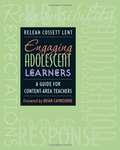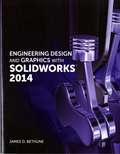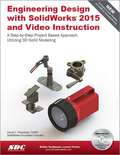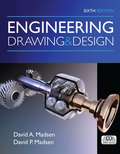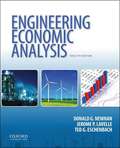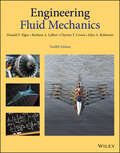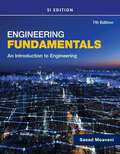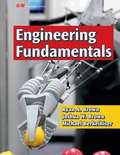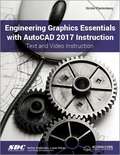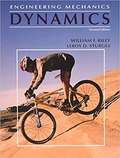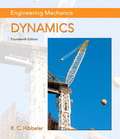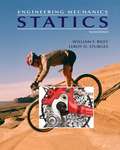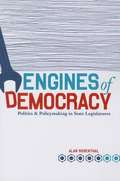- Table View
- List View
Engaging Adolescent Learners: A Guide for Content-area Teachers
by Releah Cossett LentExamine what it means to engage young adults in their learning and find out what classrooms with engaged students look, sound, and feel like. Let Releah Lent help you transform your classrooms into places where students have the freedom to satisfy their natural inclination to explore. With Engaging Adolescent Learners at your side, you'll have everything you need to help even the most reluctant students find a way to learn that works for them.
Engineering Design and Graphics With Solidworks 2014
by James D. BethuneEngineering Design and Graphics with SolidWorks 2014 shows students how to use SolidWorks to create engineering drawings and designs. The book focuses on the creation of engineering drawings, including dimensions and tolerances and the use of standard parts and tools. Each chapter contains step-by-step sample problems that show students how to apply the concepts presented in the chapter. Effective pedagogy throughout the texthelps students learn and retain concepts: Objectives: Each chapter begins with objectives and an introduction to the material. Summaries: Each chapter concludes with a summary and exercise problems. Numerous illustrations: The multitude of illustrations, accompanied by explanatory captions, present a visual approach to learning. Students see in the text what they see on the screen with the addition of explanatory text. Practical application: The text provides hundreds of exercise projects of varying difficulty (far more than any other computer graphics text). These exercises reinforce each chapter's content and help students learn by doing. Flexibility: With the hundreds of problems presented in the book, instructors can assign different problems within the same class and from year to year without repeating problems for students. Meets standards: The text teaches ANSI standards for dimensions and tolerances. This helps students understand how their designs are defined for production and the importance of proper tolerancing. Step-by-step approach: In presenting the fundamentals of engineering drawing using SolidWorks, the text uses a step-by-step approach that allows students to work and learn at their own pace.
Engineering Design with Solidworks 2015 and Video Instruction
by David C. PlanchardEngineering Design with Solid Works 2015 and video instruction is written to assist students, designers, engineers and professionals. The book provides a solid foundation in Solid Works by utilizing projects with step-by-step instructions for the beginner to intermediate SolidWorks user. Explore the user interface, CommandManager, menus, toolbars and modeling techniques to create parts, assemblies and drawings in an engineering environment.
Engineering Economic Analysis
by Donald G. Newnan Jerome P. Lavelle Ted G. EschenbachThe twelfth edition of the market-leading Engineering Economic Analysis offers comprehensive coverage of financial and economic decision making for engineers, with an emphasis on problem solving, life-cycle costs, and the time value of money. The authors' concise, accessible writing, practical emphasis, and contemporary examples linked to students' everyday lives make this text the most popular among students. In addition, with its extensive support package and logical progression of topics, this is the easiest book to teach from.
Engineering Fluid Mechanics
by Donald F. Elger Clayton T. Crowe John A. Roberson Barbara A. LebretEngineering Fluid Mechanics guides students from theory to application, emphasizing critical thinking, problem solving, estimation, and other vital engineering skills. Clear, accessible writing puts the focus on essential concepts, while abundant illustrations, charts, diagrams, and examples illustrate complex topics and highlight the physical reality of fluid dynamics applications. Over 1,000 chapter problems provide the "deliberate practice"―with feedback―that leads to material mastery, and discussion of real-world applications provides a frame of reference that enhances student comprehension. <P><P> The study of fluid mechanics pulls from chemistry, physics, statics, and calculus to describe the behavior of liquid matter; as a strong foundation in these concepts is essential across a variety of engineering fields, this text likewise pulls from civil engineering, mechanical engineering, chemical engineering, and more to provide a broadly relevant, immediately practicable knowledge base. Written by a team of educators who are also practicing engineers, this book merges effective pedagogy with professional perspective to help today’s students become tomorrow’s skillful engineers.
Engineering Fundamentals: An Introduction to Engineering, SI Edition
by Saeed Moaveni Aly El-IrakiDevelop the strong problem-solving skills and foundation in fundamental principles you need to become an analytical, detail-oriented and creative engineer with Moaveni's ENGINEERING FUNDAMENTALS: AN INTRODUCTION TO ENGINEERING, SI, 7th Edition. You begin by studying what engineers do with special behind-the-scenes glimpses into areas of specialization. Updates throughout this edition candidly examine what is required to succeed as an engineer today. This edition includes a new chapter on Python and offers more content on climate change and sustainability. The author introduces basic physical concepts and laws that you will encounter in future studies as well as on the job. Professional Profiles highlight the work of practicing engineers around the globe and further emphasize principles that you need to master to thrive as an engineer. WebAssign digital resources are also available to strengthen your understanding.
Engineering Fundamentals: Design, Principles, And Careers
by Ryan A. Brown Joshua W. Brown Michael BerkeihiserNIMAC-sourced textbook
Engineering Graphics Essentials With AutoCAD 2017 Instruction
by Kirstie PlantenbergEngineering Graphics Essentials with AutoCAD 2009 Instruction covers the main topics of engineering graphics, including tolerancing and fasteners, giving the user a basic understanding of how to create and read engineering drawings as well as teaching them the fundamentals of AutoCAD 2009.
Engineering Mechanics: Dynamics
by William F. Riley Leroy D. SturgesEngineering Mechanics: Dynamics presents the fundamentals of kinematics in a practical way with immediate real-world relevancy. Covering the physics of movement as it relates to particles and rigid bodies, this book explores the applications of Newton's laws, impulse, momentum, work and energy, vibrations, and much more. In-text conceptual examples illustrate difficult concepts, and end-of-chapter problems help students test both their theoretical and practical understanding. Call-out boxes highlight critical laws and theorems, while color diagrams and charts clarify complex concepts.
Engineering Mechanics: Dynamics
by Russell HibbelerA Proven Approach to Conceptual Understanding and Problem-solving Skills <P><P> Engineering Mechanics: Dynamics excels in providing a clear and thorough presentation of the theory and application of engineering mechanics. Engineering Mechanics empowers students to succeed by drawing upon Professor Hibbeler’s everyday classroom experience and his knowledge of how students learn. This text is shaped by the comments and suggestions of hundreds of reviewers in the teaching profession, as well as many of the author’s students. <P><P> The Fourteenth Edition includes new Preliminary Problems, which are intended to help students develop conceptual understanding and build problem-solving skills. The text features a large variety of problems from a broad range of engineering disciplines, stressing practical, realistic situations encountered in professional practice, and having varying levels of difficulty.
Engineering Mechanics: Statics
by I. C. JongThis textbook and the following volume, Engineering Mechanics: Dynamics, are designed with a goal to provide students with a clear and thorough presentation of some well-understood basic principles and their application to the analysis of any problem in engineering mechanics in a concise and logical manner. It is hoped that this text will help instructors achieve this goal in their teaching of students in the first courses in statics and dynamics, which are in most cases offered in the sophomore or junior year in engineering curricula. In the development of the text, students are assumed to have certain basic background in algebra, geometry, trigonometry, and calculus. Nevertheless, a prior course in college physics normally enables students to attain a higher degree of readiness for learning the first courses in engineering mechanics.
Engineering Mechanics: Statics
by William F. Riley Leroy D. SturgesThese exciting books use full-color, and interesting, realistic illustrations to enhance reader comprehension. Also include a large number of worked examples that provide a good balance between initial, confidence building problems and more advanced level problems. Fundamental principles for solving problems are emphasized throughout.
Engineering the Future: Science, Technology and the Design Process
by Museum Of ScienceNIMAC-sourced textbook
Engines Of Democracy: Politics And Policymaking In State Legislatures
by Alan RosenthalState legislators have often been in the shadow of their national counterparts, but they drive the processes of democracy. Rosenthal brings together a lifetime of research and experience on state legislative politics into one eminently readable volume, Building on earlier work with new data and recent interviews and observations, Both a complement and contrast to the policymaking process on Capitol Hill, Engines of Democracy proves that no one gives insight into state legislators and their work the way Alan Rosenthal can.
England in Literature
by Scott ForesmanEngland in Literature has eight chronological units presenting a survey of major British writers from the beginning until the present time.
English pupil's books Grade 07
by Panel of experts of the ministry of education Sri Lanka - අධ්යාපන අමාත්යාංශයේ විෂය විශේෂඥ මණ්ඩලයක් විසිනි.07 වන ශ්රේණියේ ඉංග්රීසි විෂය සඳහා රජය විසින් නිර්දිෂ්ට පාඨ ග්රන්ථයයි.
English (Apexit) class 12 - GSTB: અંગ્રેજી અપેક્ષિત ધોરણ ૧૨ પ્રશ્નસંગ્રહો (માર્ચ, 2020ની બોર્ડ-પરીક્ષા માટે લેટેસ્ટ પેપર-પેટર્ન અનુસાર)
by Navneetધોરણ ૧૨ અપેક્ષિતમાં ૫ વિભાગ આપેલ છે જેમાં ૨૧ પ્રશ્નસંગ્રહો આપેલ છે અને ૨ આદર્શ પ્રશ્નપત્ર આપેલ છે.
English (Apexit) class 12 - GSTB
by Navneetધોરણ ૧૨ અપેક્ષિતમાં ૫ વિભાગ આપેલ છે જેમાં ૨૧ પ્રશ્નસંગ્રહો આપેલ છે અને ૨ આદર્શ પ્રશ્નપત્ર આપેલ છે.
English (Second Language) class 1 - GSTB
by Gujrat Rajya Pathypustak Mandalધોરણ 1 અને 2 માં વિદ્યાર્થીઓના માત્ર શ્રવણ અને કથન કૌશલ્યો પર જ ધ્યાન કેન્દ્રિત કરીશું. વાંચન અને લેખન કૌશલ્યો શીખવાની પ્રક્રિયા ધોરણ 3 થી ચાલુ થશે.
English (Second Language) class 12 - GSTB: અંગ્રેજી (દ્વિતીય ભાષા) ધોરણ ૧૨
by Navneetનવનીત અંગ્રેજી SL 12મા ધોરણનું પુસ્તક, શાળાના વિદ્યાર્થીઓ માટે યોગ્ય. આ એક નવો અભિગમ છે, ખાસ કરીને બાળકો માટે. આ પુસ્તકો બાળકોની મૂળાક્ષરો સમજવા અને શીખવાની ક્ષમતામાં સુધારો કરે છે. આ વિવિધ વિષયો પરનું અત્યંત આકર્ષક અને આકર્ષક પુસ્તક છે.
English (Second Language) class 2 - GSTB
by Gujrat Rajya Pathypustak Mandalધોરણ 1 અને 2 માં વિદ્યાર્થીઓના માત્ર શ્રવણ અને કથન કૌશલ્યો પર જ ધ્યાન કેન્દ્રિત કરીશું. વાંચન અને લેખન કૌશલ્યો શીખવાની પ્રક્રિયા ધોરણ 3 થી ચાલુ થશે.
English (Second Language) class 3 - GSTB
by Gujrat Rajya Pathypustak Mandalધોરણ - 3 થી વાંચન અને લેખન કૌશલ્યો શીખવવાની પ્રક્રિયા શરૂ કરીએ છીએ. વાંચન અને લેખન કૌશલ્યોનો પ્રારંભ કરાવવા માટે આ પાઠ્યપુસ્તક ઘડાયું છે. જે શબ્દો બોલતાં આવડે છે તે શબ્દોનું હવે વાંચન અને લેખન શીખવાનું છે.પ્રસ્તુત પુસ્તક દ્વારા વિદ્યાર્થીઓને ગમતી પ્રવૃત્તિઓનો સમાવેશ કરીને હસતાં રમતાં અંગ્રેજી આવડે તેવો પ્રયાસ છે.
English (Second Language) class 5 - GSTB
by Gujarat State Board of School TextbooksThe provided textbook for Standard 5 English (Second Language) is designed to develop multilingual communication skills in young learners as outlined in the NEP 2020. The book includes activities such as stories, action songs, games, and exercises to make learning engaging and effective. It emphasizes listening and speaking skills initially and gradually incorporates reading and writing. The text aims to teach English in a fun, interactive manner, avoiding traditional translation methods and extensive grammar explanations. Activities are structured to enhance vocabulary through context and real-life application. Additionally, the book supports continuous assessment and encourages the use of local resources and teaching aids to facilitate effective language learning.
